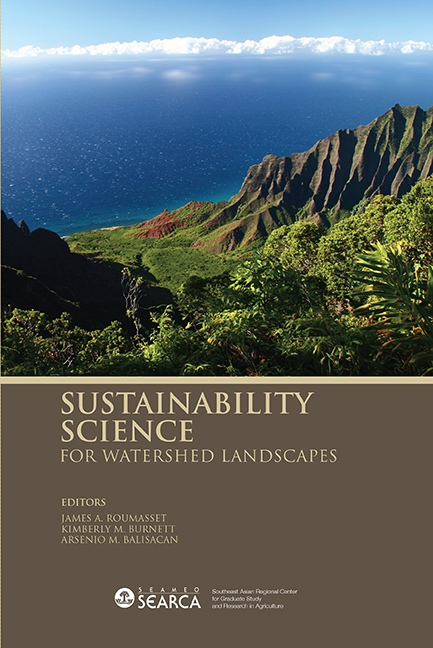Book contents
- Frontmatter
- Contents
- Tables
- Figures
- Message
- Foreword
- Preface
- Acknowledgments
- List of Contributors
- Theme 1 Sustainability Science for Resource Management and Policy
- Theme 2 Monitoring and Modelling
- 5 Cyberinfrastructure for Sustainability in Coupled Human – Environment Systems
- 6 Watershed Management for Sustainability in Tropical Watersheds: An Integrated Hydrologic Modelling Approach
- 7 Watershed Assessment, Restoration, and Protection in Hawaiʿi
- Theme 3 Participatory Approaches
- Theme 4 Case Studies
- Synthesis
5 - Cyberinfrastructure for Sustainability in Coupled Human – Environment Systems
from Theme 2 - Monitoring and Modelling
Published online by Cambridge University Press: 21 October 2015
- Frontmatter
- Contents
- Tables
- Figures
- Message
- Foreword
- Preface
- Acknowledgments
- List of Contributors
- Theme 1 Sustainability Science for Resource Management and Policy
- Theme 2 Monitoring and Modelling
- 5 Cyberinfrastructure for Sustainability in Coupled Human – Environment Systems
- 6 Watershed Management for Sustainability in Tropical Watersheds: An Integrated Hydrologic Modelling Approach
- 7 Watershed Assessment, Restoration, and Protection in Hawaiʿi
- Theme 3 Participatory Approaches
- Theme 4 Case Studies
- Synthesis
Summary
ABSTRACT
A critical challenge facing scientists, policy makers, and citizens of communities is to affect a transition into sustainability in coupled human-environment systems. This transition must be science-driven and effective enough to meet projected human development needs and at the same time protect the earth's life support systems.
Knowledge systems that are generated by science, however, are often de-coupled from decision-making and the translation of information into action and policy. Emerging cyberinfrastructure, viewed as the coordinated aggregate of computer hardware and software, and other technologies, which changes data into knowledge, has great potential to connect science with policy action. This is accomplished through the effective integration and delivery of information to end users about the condition of human-environment systems at the global scale.
This paper provides a brief overview of a new cyberinfrastructure, which was originally developed for monitoring human-environment systems at the regional scale in the Hawaiian Islands. This emerging technology successfully synthesised the use of wireless sensor technologies, grid computing with 3D geospatial data visualisation and exploration, and a secured Internet portal user interface. This platform has significant power to crossconnect science and decision makers beyond boundaries to promote sustainable development at the global scale. A use case example is provided in which native Hawaiian residents of Waipa Valley (Kauaʿi) utilised the technology in monitoring the effects of regional weather variations on surface water quality and quantity response to better understand their local hydrologic cycle and promote the sustainable use of biophysical resources in their “mountain-to-sea” environment.
INTRODUCTION
Land conversion and resource use is a trait that is characteristic of human society. Collective human action has resulted in the accelerated pace of ecosystem degradation at the global level and the loss of the services they provide.
To reverse this alarming trend, scientists, policy makers, and citizens of communities must facilitate the transition of society into a sustainable state to meet human development needs, protect the earth's life support systems, and maintain ecosystem health and integrity (e.g. Cash 2000; Pfirman 2003).
- Type
- Chapter
- Information
- Sustainability Science for Watershed Landscapes , pp. 127 - 140Publisher: ISEAS–Yusof Ishak InstitutePrint publication year: 2010



